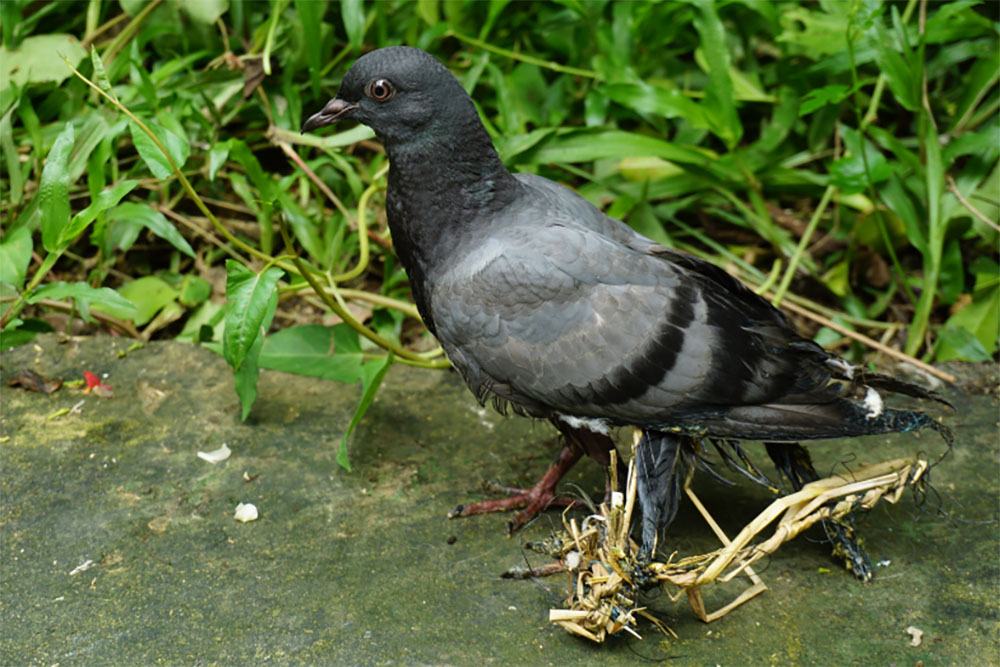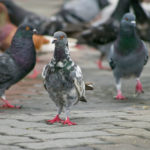Pigeons can be found all over the world in a variety of different shapes and sizes.
The different breeds vary in plumage and beak shape, but most of them share the distinctive stout body shape and slender bill.
It is not uncommon to see pigeons in both cities and rural areas, and many people keep them as pets or racing birds.

Sometimes you may come across a pigeon that is injured or otherwise stuck and be tempted to help it.
Perhaps the bird has flown into your house and is struggling to escape, or it is caught on a piece of wire.
Whatever the case, catching live birds of any variety can often be difficult and stressful, to say the least, but there are useful techniques you can use to catch pigeons safely without causing them any harm.
This guide will tell you how to approach and catch a pigeon so that they can be released back into the wild, or handed to a vet for treatment of any injuries.
Is It Safe To Catch A Pigeon?
Sadly pigeons have a somewhat bad reputation and many consider these beautiful birds to be naught but “winged rats”.
Regardless of your stance on these birds, you should always treat them as humanely as possible when trying to catch them, if not for moral reasons then simply because it may be someone’s pet.
Contrary to popular belief, you will not get sick from touching a pigeon.
While their dropping can spread some illnesses, you won’t catch any bacteria from touching these birds that can’t be instantly removed by washing your hands with soap and water.
Perhaps you are less worried about yourself and more concerned about harming the bird in the process of catching it.
Just remember that you are very unlikely to give a pigeon a heart attack by catching it unless it was already at death’s door anyway.
Given all the natural predators that eat pigeons, an injured, sick or domesticated bird is going to be far worse off if you don’t catch it.
Creating A Simple Pigeon Trap
Often, unless a pigeon is severely injured and unable to fly, your best bet at catching them will be to trap it.

There are several ways this can be done without harming the bird and often all you will need is a large basket or other suitably sized receptacle, and some seeds, oats, or crushed-up cornflakes to use as bait.
With these tools, you can place the basket over the pigeon in a rapid but controlled manner to capture it without causing injury.
If the bird panics inside the box, you can often calm it down by placing a large blanket over the trap.
With this done you can try to put your hand under the basket and lightly pin the pigeon to the ground. With this done you can remove the box and pick up the bird.
If you aren’t comfortable with placing the box yourself, you can simply prop it up with a stick attached to some string or chord.
This is a simple trap design you may have seen in cartoons, just place the seed under the propped-up box and pull on the rope to remove the stick once the pigeon is safely underneath.
Some birds will be more nervous around humans than others so when attempting to lure the pigeon under the trap it is a good idea to stand as far back as your string will allow.
Catching A Pigeon By Hand
Getting hold of any bird with your bare hands is very difficult unless it is very sick or badly hurt.
Sometimes you may encounter a domesticated pigeon that is performing what is known as a self-rescue.
These birds lack the skill to survive in the wild and you may encounter one in your garden seeking a home familiar to the one it has left.
Although they may be looking for help these birds will still fly away if you make sudden movements so you’ll need to approach them in the right way to have any chance of catching them.
Chase It Into A Corner
A severely injured or sick pigeon may not be able to fly and as such will be much easier to catch.
Simply herd the grounded bird into a corner where it cannot escape and place your hands securely around its wings.
Any pigeon that can be picked up this easily is likely to have damaged wings or be critically dehydrated, hungry, or sick so you should contact an animal welfare organization as soon as you have it secured.
Locating A Pigeons Nest
If you see an injured pigeon that is still very capable of flying, you should always consider whether you can use one of the traps above before trying to catch it.
If you can’t trap it, then one of the easier ways to catch a pigeon by hand is to catch it at night while it is roosting.
Since pigeons have poor night vision they are often reluctant to fly away from predators at night, preferring to stay still and hope to go unnoticed.
Monitor the pigeon you want to catch carefully and try to find its nesting spot.
Once you know where it roosts you can go there at night with a ladder, be careful not to fall and injure yourself in the process.
When doing this you should try to rely on your own night vision as bright lights will startle the bird and cause it to try and escape.
When you can see the pigeon clearly, confidently reach for it with both hands and grab it around the wings.
It will try to struggle, but if you get your hands over its wings you should be able to keep hold of it and secure it against your breast.
The Bait And Pounce Technique
If you see a pigeon with string or some other harmful material around its leg, you may want to quickly catch it to remove the detritus and immediately release it again.
For this, you may need to try pouncing on the pigeon from above. This can be done by sprinkling food to attract a flock of pigeons.
Keep feeding them while you watch the one you intend to catch. Since all the birds are distracted eating, you should be able to get within a foot of your target.
Once your hand is hovering directly over it and you are ready, rapidly lower your hand to pin the pigeon to the ground, don’t worry about hurting it as long as you don’t use the excessive force you are unlikely to.
If you succeed at pinning the pigeon you will be able to scoop it up with your other hand and hold it up against your chest.
Those nervous about attempting this method should practice beforehand on a shoe or other small object.
What To Do Once You Have Caught The Pigeon
It is important once you have a pigeon secured to take it indoors to keep it safe until you can find a safe home for it. Leaving it outside in a cage will only attract predators and cause the bird more distress.

You can create a simple nesting box for the pigeon with any basket, cage, or cardboard box as long as you place a cover over the top to prevent it from flying away.
Remember to always wash your hands after handling pigeons just to prevent any chance of catching an illness.
There are several specialized vets and other organizations that will take and look after an injured pigeon once you have caught it.
If it has something caught around its leg you should be able to remove it and release the bird with relative ease.
Pigeons with a plastic ring around one leg are likely homing or racing pigeons that belong to someone. The ring will often have contact details so you can return the pigeon to its rightful owner.






